In this article, we lost and briefly explain sixteen (16) types of ivy by species and six (6) other types of plants called ivy. Keep reading for more information on ivy plants and the different existing types of ivy.
The Ivy plant is a notoriously popular evergreen climbing shrub. They are known for growing almost anywhere and climbing or creeping onto surfaces such as fences, walls or the bark of trees for support.
Ivy is a very adaptable plant; it does not require exposure to large amounts of sunlight or water to flourish hence it grows well in all conditions whether it be in the heat of summer or in the coldest winter.
They are probably the most versatile plants and can adapt to any situation as they can grow well as an attractive groundcover, hedges, and climbers and they even make excellent houseplants.
The term “evergreen” refers to the fact that it’s present all year round. A true ivy must belong to the genus Hedera in the Araliaceae family.
The English Ivy is a well-known ivy plant in the genus Hedera and is generally considered an invasive species. There are approximately 15 known types of climbing shrubs in this genus.
Ivies are considered an invasive and aggressive species because they are known to spread out of control like wildfire in their new habitats.
Competition and overpowering of other plants in their habitats in the struggle for nutrients and sunlight is not a new phenomenon to the ivy plant.
The leaves of plants belonging to the family Araliaceae, are characterized by either a vivid shade of green or can be multi-coloured depending on their varieties.
They are also known to possess glowing bright green veins present in their intricate structure which serves as a network in the transportation of food and water throughout the plant.
Their leaves are often large in size and can come in various shapes such as lobed (with major projections on the sides of the leaf) or palmate (“palm-like”, resembling the shape of a hand with outstretched fingers), depending on the type of the plant.
Table of Contents
Ivy Growth Habits
The ivy plant has two growth stages in its life – juvenile and adult – in which their growth habits and leaf shape differ. In the juvenile stage of an ivy plant, the plant grows along the ground searching for a structure to affix itself on.
It has climbing stems with pinnate roots growing along the body of the stem that exudes a glue-like substance which allows it to properly attach itself to the substrate such as the bark or root of a tree.
In this stage, the plant spends all its time and energy seeking vertical surfaces in order to creep and climb on to get as close as possible to sunlight.
On level ground, they remain creeping and do not exceed heights of 2 to 7 inches but on surfaces meant for climbing, like trees, buildings or fences, they can reach impressive lengths growing all the way up to about 90 feet tall.
Once the plants are well adapted to their environment, growth switches to the adult phase. The adult stage of an ivy plant is characterized by the shiny and glossy appearance of its leaves, flowers and small dark-coloured berries.
In this stage, the ivy plant has fully adapted to its surroundings and therefore focuses its time and energy on blooming and growing flowers and berries.
The berries serve as an important source of food for birds, bees, butterflies and other wildlife. It also acts as an ornamental plant complementing the natural beauty of its surroundings.
Growth Habitats
The ivy plant is indigenous to most of Europe and Western Asia but it can also be found in North Africa, North America and Canada.
Ivies propagate in a wide range of climates and are known to withstand really cold winters and hot summers, however, they have been found to prefer temperate regions.
They are known for their versatility and adaptability and can be found in both natural and urban environments.
In their natural habitat, they are mostly reproduced from seeds dispersed by birds when they eat the fruit. Meanwhile, in an urban setting, they are propagated vegetatively by humans and kept as houseplants.
In the great outdoors, ivies are found in forests, uncultivated lands, along the banks of rivers and streams, on isolated trees and fields. They do not do well in very arid or waterlogged soils. Ivies can grow in a wide range of soil pH excluding extremely acidic soils.
It is also one of the few exotic plants that is known to thrive both in sunlit areas and in deep shade with its leaves seen all year round, flowering from September to November with its fruits ripening in November to January.
Types of Ivy by Species
1. Algerian Ivy

- Botanical name: Hedera canariensis
- Other names: Canary Island ivy, Canary ivy, Coney Island ivy, Madeira ivy
- Height: 20 to 40 feet
The Hedera canariensis commonly called Algerian ivy is an evergreen, perennial woody vine native to Northern Africa and Algeria. It is a fast-growing species of ivy with shiny, dark green, lobed leaves and reddish-pink stems.
This plant can grow as tall as 40 feet with its leaves spanning about 4 to 5 inches across. It hardly produces blooms but when it does, they are whitish-green in color.
This plant has both the dark green variety and the variegated variety but the variegated type is more commonly seen.
The variegated leaves have a lustrous texture and are either deep dark green or pale green with patches of creamy white at their edges, making it a highly sought-after plant by plant lovers because of its beauty.
2. Azores Ivy

- Botanical name: Hedera azorica
- Other names: N/A
- Height: 90 feet
The Hedera azorica is an evergreen, perennial, woody, climbing plant indigenous to the Atlantic coast in the Azores Islands.
This plant is mostly found in tree trunks, rocky slopes and the soil in temperate biomes such as forests, grasslands, shrublands, which may vary widely but all have relatively mild temperatures.
The Azores ivy has large leaves alternately placed on the sides of its stem. The leaves are lime green in color with five lobes and they have a heart-like shape.
The adult plants produce small clusters of yellow-green flowers on a long stalk which later produce small, spherical black fruits.
3. Baltic Ivy
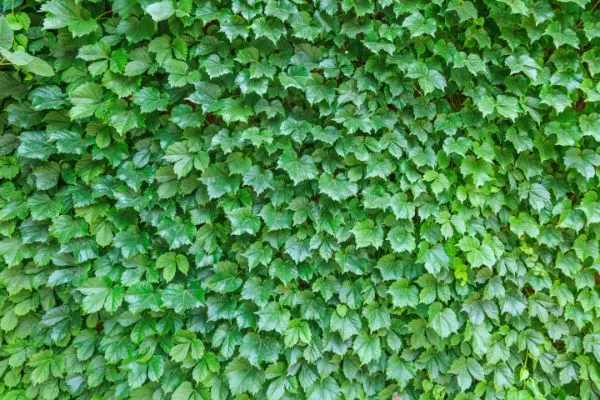
- Botanical name: Hedera helix baltica
- Other names: N/A
- Height: 20 to 80 feet
The Hedera helix baltica, commonly referred to as the Baltic Ivy, is an evergreen, perennial, vigorous climber with smaller leaves in comparison to the English Ivy. It is a species native to Europe with dark green colored leaves and intricate white veins etched on the surface.
Although this type of ivy is most tolerant of cold harsh weather conditions, which makes it ideal for northern zones, it performs extremely well in either full sun and full shade.
The baltic ivy requires moist, well-drained, fertile and humus-rich soil for optimal growth. The invasiveness of the Baltic ivy species is very robust.
In general, the English ivy is known for its vigorous growth but the Baltic ivy is extremely fast growing and can quickly spread, taking over large areas and resulting in a significant decrease in the biodiversity of plants in that habitat.
4. Bettina Ivy
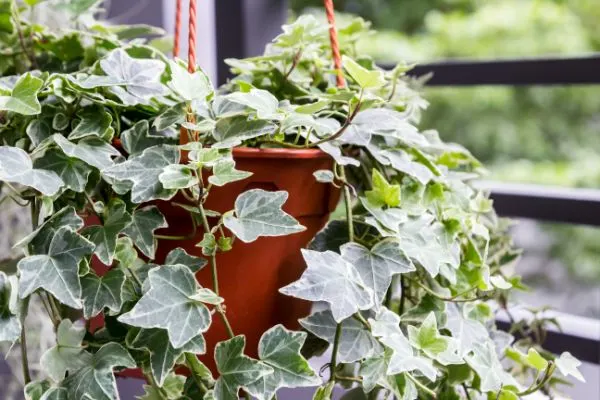
- Botanical name: Hedera helix bettina
- Other names: English ivy
- Height: 50 feet
Hedera helix Bettina is a perennial woody vine native to Europe and Western Asia. It is a compact type of ivy reaching heights of about 8 to 12 inches with a spread of about 12 to 16 inches.
The leafage of this plant is dark green and glossy in appearance with cream or white margins. The leaves are lobed with a distinctive three lobed shape.
It does well in well draining soil with a pH range of about 6.1 to 7.5. It is great to use as a houseplant in a hanging basket or as a ground cover.
5. Cyprus Ivy
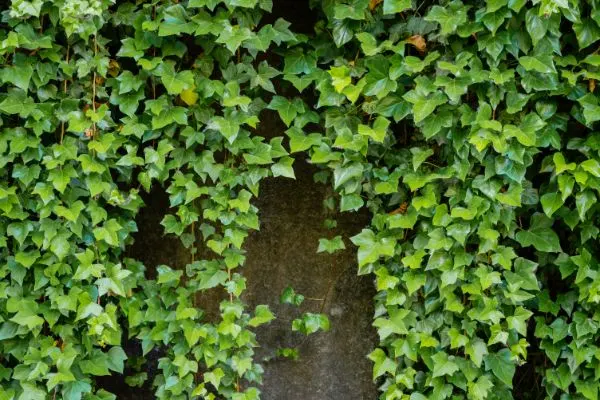
- Botanical name: Hedera cypria
- Other names: N/A
- Height: 90 feet
The Hedera Cypria commonly called Cyprus Ivy is a hardy, evergreen vine indigenous to the island of Cyprus. This woody vine exhibits climbing traits and can grow as high as 90 feet tall provided there is a suitable surface for creeping.
It is commonly found in higher altitudes on rocky terrain and narrow valleys over 2000 feet high. Unlike the other types of the ivy plant, the Cyprus ivy is a slow grower.
The leaves of this plant are medium-sized and oval in shape. In its juvenile stage, the leaves of this plant are almost unlobed with an almost triangular shape.
Meanwhile, in its fertile flowering stage, its leaves become unlobed and narrower compared to the English ivy.
The surface of the leaf is deep green with splotches of greenish-yellow to gray leaf veins stemming from the center of the leaf outwards to the margin.
It also has red stems which set it apart visually from other ivies. At its mature stage, the Cyprus ivy yields fruits which are black in color.
6. English Ivy
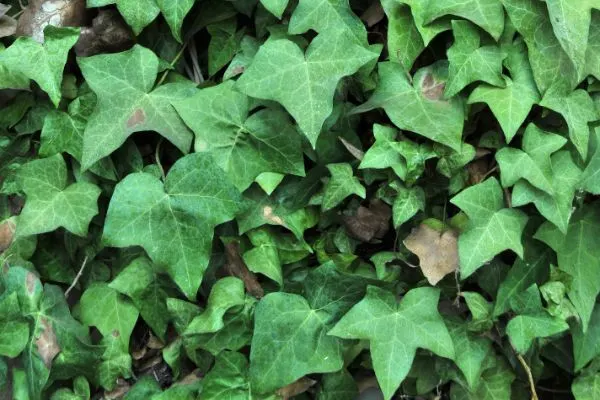
- Botanical name: Hedera helix
- Other names: Common ivy, European ivy
- Height: 20 to 80 feet
The Hedera helix commonly known as the English ivy is a fast-growing, evergreen perennial plant native to Western Asia and Europe.
It exhibits a climbing habit and possesses aerial rootlets alternately arranged along its stems. These rootlets allow for the plant to adequately adhere to different structures.
As a climbing vine, it can grow as high as 20 to 80 feet, possibly more. This attribute adds to its popularity as an ornamental plant in gardens and landscapes.
This plant is easily grown in medium, well-drained soils and performs well in alkaline soils. In its juvenile stage, the leaves are smaller in size, shiny, and possess roughly about three to five lobes.
Newly grown ivy plants are bright green in color but turn a darker shade of green as the foliage matures. In the adult phase of the English ivy, the leaves undergo a major transformation.
They become broader and longer with less pronounced lobes or may be completely lobeless. They appear on rootless stems that do not spread or climb.
In the fall season, these leaves bloom, producing a dome-like cluster of flowers which are greenish-white in color followed by dark-coloured berries.
7. Himalayan Ivy
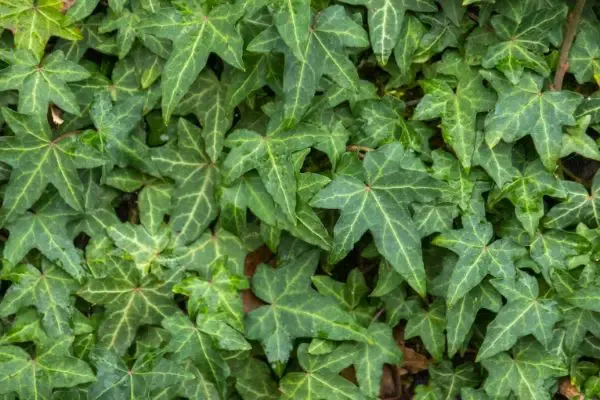
- Botanical name: Hedera nepalensis
- Other names: Nepalese ivy
- Height: 50 feet
Hedera nepalensis is an evergreen, woody perennial vine. It is native to SouthEast Asia but can be particularly found in Nepal, Bhutan, China and India.
In its juvenile stage, the plant is ovate and diamond-shaped with bold, green foliage and light gray-white veins. It can grow as tall as 50 feet and more.
The leaves of the Himalayan ivy can grow up to 6 inches long. All parts of the vine are toxic and the foliage blooms in its mature stage, to form dome-like clusters of greenish-white flowers from September till October.
This is followed by yellow berry-like fruits which ripen to black berries, although they are not edible or of ornamental value.
This type of ivy requires either bright, indirect exposure to sunlight or partial shade and is highly tolerant to drought. It grows best in slightly acidic soil with a pH of 6.5.
8. Iberian Ivy
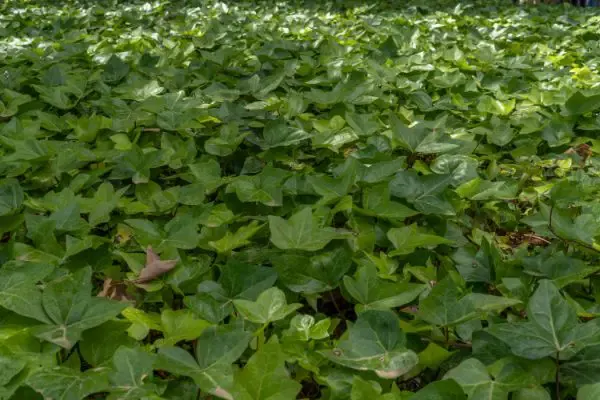
- Botanical name: Hedera iberica
- Other names: N/A
- Height: 90 feet
The Hedera iberica is a type of ivy that is native to the Iberian peninsula of Portugal and Southwest Spain, and can also be seen in some parts of Morocco.
It is a vigorous, fast growing, evergreen woody vine with it growing as high as 90 feet tall and possibly more, provided climbing surfaces are available.
In its juvenile stage, the leaves of this plant are lobed with about three to five lobes and glossy green in color. On the surface of the leaves are prominent veins.
In the adult phase, the plant matures and the lobed leaves gradually become unlobed. The plant flowers from April to December, and during that time, the plant blossoms to produce flowers.
The flowers of the Iberian ivy are small, in clusters and dome-like. They are greenish yellow in color and ripen to form black berry-like fruits.
The Iberian ivy is not half as invasive as the English ivy however, it can still spread on its own under favorable conditions. They can grow in various soil types, provided they are well drained.
Its stems are greenish-brown, with a reddish or purple tint. Basically, this type of ivy can be found growing on the trunks of trees, rocky slopes and rocks.
9. Irish Ivy
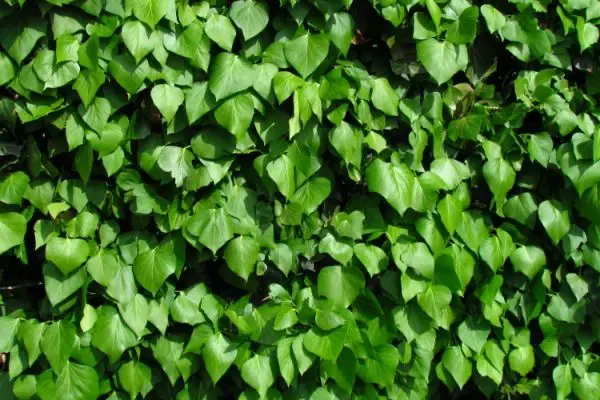
- Botanical name: Hedera hibernica
- Other names: Atlantic ivy
- Height: 32 feet
The Hedera Hibernica popularly known as the Irish ivy is a fast-growing evergreen vine which is indigenous to the Western part of Europe bordering the Atlantic Ocean.
The leaves of Irish ivy are larger than the English ivy and on the leaves, the veins are light and less prominent. The surface of the leaf has a shiny green luster while the underside is a pale green.
The juvenile phase of the leaves is three-lobed, while the adult phase of the leaves is usually five-lobed.
The flowers of Irish ivy are borne in the adult stage in clusters and are canopy-like. The fruits are dark-coloured berries and they are poisonous together with the entire plant.
When it comes to growing conditions, Irish ivy requires moderately moist soil to grow. It prefers well-drained, humus-rich soils with an alkaline pH in order to sprout rapidly.
Compared to the English ivy, this type of ivy is more resilient to wetter environments and may grow in regions with more rainfall. It is also much more invasive than the English ivy.
It can tolerate full exposure to sunlight and some shade but it has been noted to grow rather rapidly and vigorously under partial shade.
10. Japanese Ivy
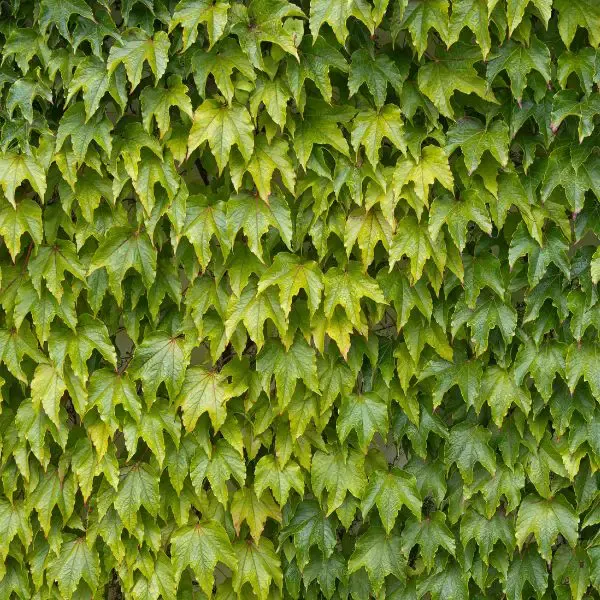
- Botanical name: Hedera rhombea
- Other names: Boston ivy, grape ivy, Japanese creeper
- Height: 30 to 50 feet
The Hedera rhombea commonly known as the Japanese ivy or Boston ivy is an evergreen woody vine indigenous to East Asia.
It is found particularly in countries like Taiwan, Korean Peninsula, Japan and China. It was formerly known as Hedera pedunculata.
The Japanese ivy has rhomboidal, dark green leaves with three to five lobes and a slightly serrated margin.
These leaves are glossy green in summer and mature to a bright red in autumn. They produce umbrella-like clusters of greenish-yellow flowers in their adult stage, from August to October.
This vigorous climber can grow to an impressive length of about 50 feet. Its habitat is mostly on rocky slopes, growing up on the trunks of trees, rock walls or shrubs in the hillsides etc.
This species prefers full exposure to sunlight to partial shade conditions and moist soil with soil types ranging from sandy loam to sandy clay.
11. Madeiran Ivy
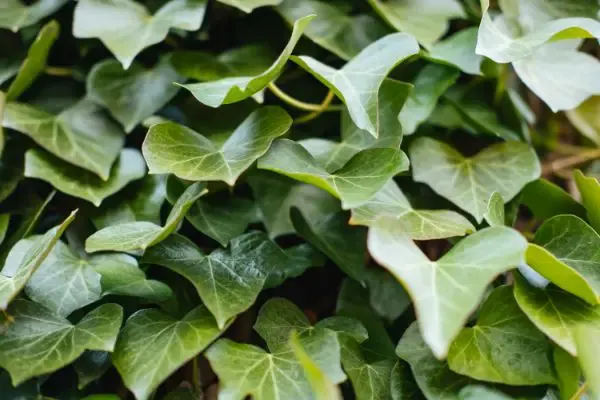
- Botanical name: Hedera maderensis
- Other names: N/A
- Height: 90 feet
The Hedera maderensis is a type of ivy plant native to the Atlantic coast in the Island of Madeira, west of Portugal.
It is a long-stemmed, woody and perennial shrub mostly found growing on rocks, tree trunks in temperate biomes like forests and grasslands.
This type of ivy is closely related to the Iberian ivy. It has large green leaves and yellow leaf veins with the leaf growing as far as 8 inches in width.
The leaves are quite leathery with shallowly lobate lobes and a central lobe that is wider than long. It can also be said to be heart-shaped.
This plant blossoms between April and December. When it matures, the flowers bloom to produce ripe black berries that are globular in shape. The peduncle of this plant is either a green or greenish brown color with a purple or reddish tint.
12. Moroccan Ivy
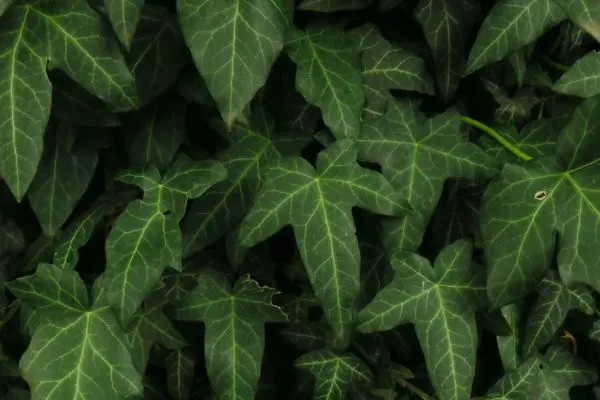
- Botanical name: Hedera maroccana
- Other names: N/A
- Height: 90 feet
Hedera maroccana is a type of ivy native to Northern Africa and other countries along the Atlantic coast, like Morocco.
It has really broad leaves which grow up to about 8 inches long and is slightly leathery to touch. The stems of this plant are green or greenish-brown, with hints of scarlet or purple.
In its juvenile stage, the lobes on the leafage are well defined with 3 to 5 lobes on each leaf and red petioles.
As the plant matures, it develops a woody stem growing to a considerable height of about 90 feet and more once it affixes itself on a vertical structure.
The Moroccan ivy blooms in its adult stage, and develops large clusters of green flowers which later produce berries that are black in color.
13. Persian Ivy

- Botanical name: Hedera colchica
- Other names: Bullock’s heart ivy, Colchica ivy, Paddy’s pride, sulfur heart
- Height: 30 feet
The Hedera colchica commonly called Persian ivy is a rapidly growing evergreen, climbing and trailing vine indigenous to the Middle East, originating in Turkey.
The shape of the leaves can either be heart-shaped or slightly lobed with a deep shade of glossy green on the surface. The leaves of this plant can grow to lengths measuring about four to ten inches long, making them the largest of all the ivy types in this genus.
The large green leaves are irregularly marked with vivid spots of yellow color. At its mature stage, when provided with suitable vertical supports, the plant can grow to heights of about 30 feet and more.
Adult forms of Persian ivy produce a cluster of greenish-white flowers which are beneficial to birds and bees but toxic to pets and humans.
The Persian ivy has cultivars. One of which is the Dentata variegata with flowers and another, called the Sulphur Heart. These cultivars may also have some variations on their leaves like silver or white spots.
Although this type of ivy is resilient to drought, it thrives well in moist, well-drained soil and in sunny or shady spots; however, it is best to plant it in partial shade.
14. Russian Ivy
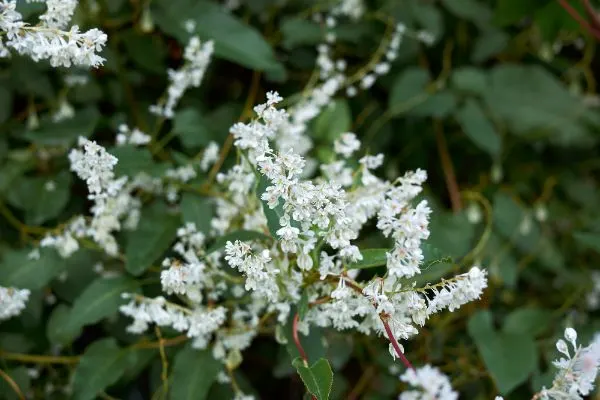
- Botanical name: Hedera pastuchovii
- Other names: Pastuchov’s Ivy
- Height: 90 feet
The Hedera pastuchovii is an evergreen woody plant native to the border of Eastern Europe and Western Asia.
It is particularly found in countries like Armenia, Georgia, outside the island of Cyprus throughout the Caucasus region, Azerbaijan and Iran.
The Russian ivy is closely related to the Cyprus ivy. However, it grows slower than the Cyprus ivy and is solid green in color unlike the Cyprus ivy which has distinct splotches of grayish white colorations.
The leaves of the Russian ivy are thin, well rounded and are a glossy light green in color. The leaves also have wavy margins and can be lobed or slightly lobed depending on their growth phase.
This ivy is set apart from other ivies because its growth habit does not allow it to act as a ground cover. It is known for climbing and can grow as high as 90 feet and more where suitable trees are available.
In its adult stage, this plant blooms to form umbrella-like clusters of small, yellow-green flowers which later ripen to form berries that are black in color.
15. White-and-Green Variegated English Ivy
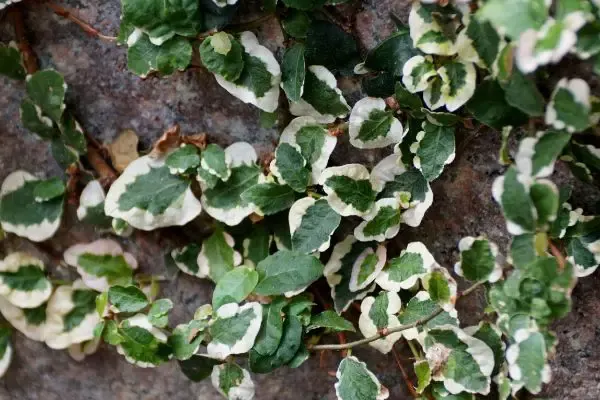
- Botanical name: Hedera helix ‘Glacier’
- Other names: N/A
- Height: 2 feet
The Hedera helix ‘Glacier’ commonly known as the variegated English ivy is a strong and sturdy evergreen ornamental plant with white-variegated green leaves.
It is known for its unique and distinct foliage pattern which makes it highly sought after by plant lovers.
It can only grow as tall as 2 feet but can spread as wide as 10 feet, taking a period of about five to ten years for this plant to reach its ultimate height.
This type of ivy plant is adaptable to different light conditions; it likes light but still needs protection from full-on sun exposure, it can also flourish in shady spots.
Although the variegated English ivy can grow in all types of soil and pH, it grows best in fruitful, lush, humus-rich alkaline soil but can also tolerate acidic soils.
16. Yellow-and-Green Variegated English Ivy
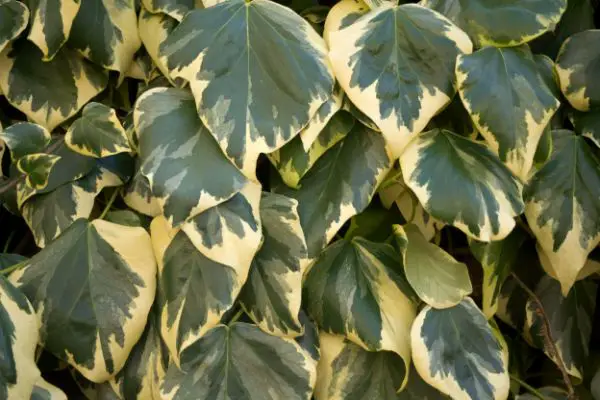
- Botanical name: Hedera helix ‘Gold Child’
- Other names: Goldchild ivy, gold baby ivy
- Height: 3 feet
The Hedera helix goldchild popularly known as Goldchild Ivy is an evergreen vine with a climbing and trailing habit of growth.
Its species are native to Europe. The foliage of this Hedera helix variety is an attractive glossy light green marked with yellow margins creating a striking variegated effect.
The leaves are pointy and heart-shaped with three to five lobes and It can grow to a height of about 3 feet or more when climbing.
This plant grows well in partial sunlight to partial shade and the maximum height to which an adult gold child ivy can grow and spread varies depending on the growth conditions and sun exposure.
The flowers and fruits of this plant however are not important ornamentally, just the leaves.
Other Types of Ivy
In this section, we would discuss the other types of ivies. Although they are not considered true ivies and are also not in the genus Hedera, they are beautiful plants which possess ivy-like qualities.
17. Devil’s Ivy
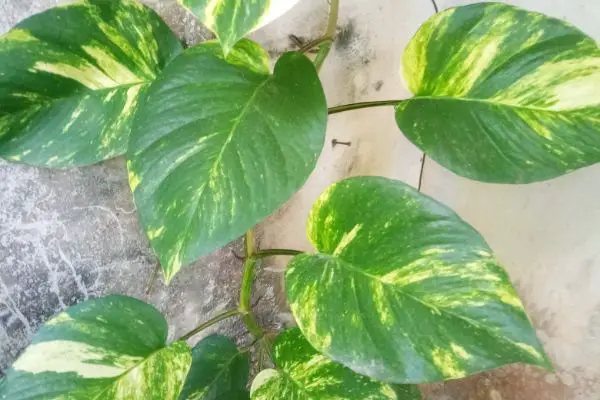
- Botanical name: Epipremnum aureum
- Other names: Golden pothos, Hunter’s rove, money plant
- Height: 20 to 40 feet
Epipremnum aureum also known as the Devil’s ivy or money plant is a perennial vine plant native to French Polynesia in the South Pacific.
It is a type of ivy in the genus Epipremnum and the arum family Araceae. In its native habitat, the devil’s ivy can grow up to 40 feet long with its large leaves extending to 3 feet in length and width.
In its juvenile phase, the leaves of the plant are heart-shaped and bright green with irregular spots of yellow or white on the surface. As the plant matures, the leaves become broader with deep lobes.
Several cultivars of the Devil’s ivy exist; some of which may include white-and-green types like ‘Marble Queen’, ‘Snow Queen and Manjula’, the vibrant yellow-green type like ‘Neon’ and the silver type called ‘Silver Satin’.
Devil’s ivy and its varieties grow well in moderate sunlight exposure; however, some cultivars like the ‘Neon’ may lose their yellow-green color if not properly exposed to bright indirect sunlight.
Regarding its soil requirements, the Devil’s ivy tolerates a range of soils but is found to perform better in slightly acidic, moderately moist and well-drained soil.
18. Fig Ivy
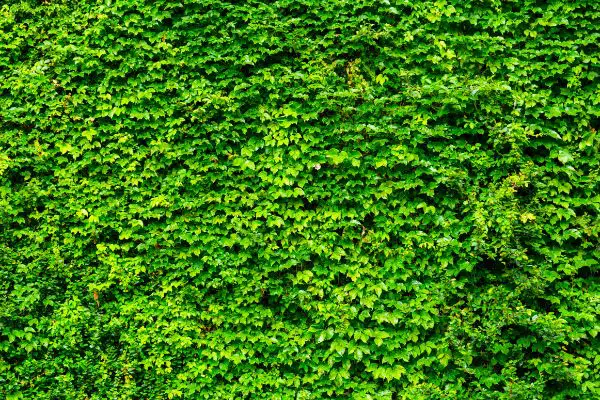
- Botanical name: Ficus pumila
- Other names: Climbing fig, creeping ficus, creeping fig vine
- Height: 20 feet
The Ficus pumila is a fast growing, evergreen and perennial vine with small heart-shaped leaves growing alternately on its stem.
The fig ivy is from the family Moraceae. It is indigenous to East Asia particularly Vietnam, China and Japan and can also be seen in parts of the United States.
In their juvenile stage, they grow very small, soft green leaves and in their adult stage, these leaves mature to a dark green with a leathery texture which is considered less attractive compared to the juvenile leaves.
Their leaves are elliptical in shape and are usually green but it also has variegated varieties. The variegated species are more striking, with either green and cream or green and white-tipped foliage.
The foliage is dense and has a glossy appearance making it look lush. The fig ivy can grow as long as 20 feet tall and spread about 3 feet and it also does well in any lighting conditions be it bright, medium or low light exposure.
The fig ivy often yields fruit which are pale green in color but eventually to a deep dark purple color.
It grows well in fertile, humus-rich, moist but well-drained soil and is a full sun to partial shade lover.
19. German Ivy
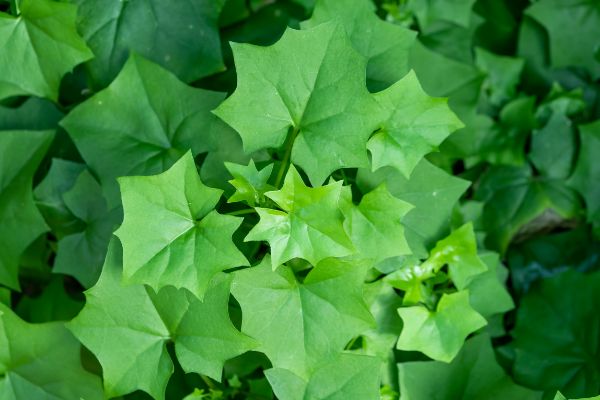
- Botanical name: Delairea odorata
- Other names: Cape ivy, Italian ivy, parlor ivy
- Height: 7 to 13 feet
The Delairea odorata is an evergreen non-woody vine native to South Africa and can be found along the California coast. It is a plant genus in the family Asteraceae.
It is quite a striking plant and is not always in bloom. Its leaves are quite large spanning up to 4 inches. When in bloom, this plant produces clusters of lightly scented, small, bright yellow flowers.
It can reproduce by seeds or by springing roots along its underground stems. The glossy foliage of the German ivy has about 3 to 10 lobes with the upper leaf surface having a purplish tint, hairless and cool to the touch.
This type of ivy plant is found in temperate regions. It prefers partial shade but can perform well in full shade and full exposure to sunlight.
Although this plant thrives in moist, well-drained soils, it can withstand droughts since it is a hardy plant. German ivy grows really fast during the fall season down to late spring.
20. Grape Ivy
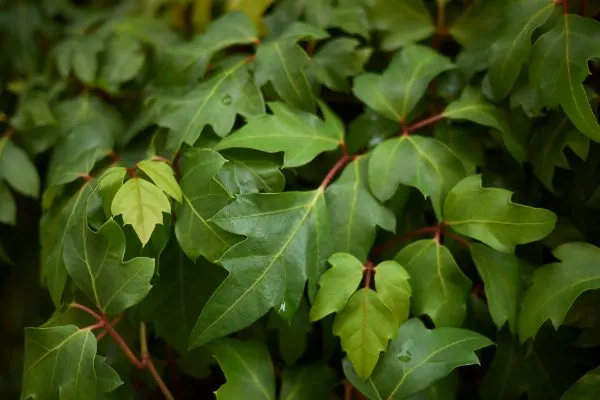
- Botanical name: Cissus alata
- Other names: Grape leaf ivy, oak leaf ivy, Venezuela treebine
- Height: 6 to 10 feet
Cissus alata is a perennial evergreen vine indigenous to Central and Southern America and the West Indies, particularly in countries like Mexico and Trinidad.
The grape ivy is from the family Vitaceae. Its leaves are exceptionally lengthy, reaching lengths of more than 6 inches and they grow in a trifoliate pattern.
The leaves of this plant are glossy green in color with a leathery feel. The shape of the leaves range from ovoid to wedge-shaped or rhomboidal with serrated edges.
In its juvenile stage, the stems of this plant are yellow with reddish hairs but as they mature, it turns deep burgundy in color.
In summer, the grape ivy plant blooms small, greenish-white flowers which are considered ornamentally insignificant followed by dark blackish-purple berries.
It prefers growing in partly shaded areas but can tolerate heavy shade and a wide range of lighting conditions.
21. Poison Ivy

- Botanical name: Toxicodendron radicans
- Other names: Eastern poison ivy
- Height: 75 feet
Toxicodendron radicans popularly known as poison Ivy is a fast-growing, woody vine native to Northern America and Asia. It is a highly poisonous plant.
It is a member of the cashew family Anacardiaceae known to cause allergic reactions in many people. It can be found in various habitats like forests, fields, along the roads, and can grow as tall as 75 feet or more.
Poison ivies are trifoliate in nature. They normally have three leaflets attached to the leafstalk which grow alternately to the stem.
The leaves may have smooth or notched margins with the colors of the leaves varying with the season. In summer, the leaves of the poison ivy plant is a brilliant green, turning scarlet or yellow in the fall season.
Mature poison ivy blooms in spring, producing small greenish-yellow flowers close to the main stem of the plant. These flowers blossom to produce poisonous, yellowish-white or light green berries.
22. Swedish Ivy
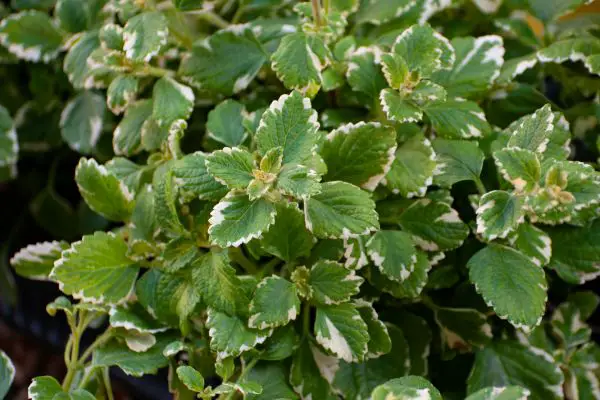
- Botanical name: Plectranthus verticillatus
- Other names: Creeping Charlie, Swedish begonia, whorled plectranthus
- Height: 2 to 3 feet
The Plectranthus verticillatus commonly known as Swedish ivy or Creeping Charlie is a herbaceous, evergreen, perennial plant indigenous to South Africa, Australia and the Pacific Islands.
The Swedish ivy is a plant in the genus Plectranthus in the family Lamiaceae. This species is not native to Sweden, however, it does get its name from there because it first gained popularity there.
This plant has a glossy appearance with small, round, deep green leaves on a reddish vine; though there are many varieties with variegated leaves having shades of green and cream.
The leaves have widely serrated or scalloped edges and when it blooms, produce pale pink, lavender or white flowers. It can grow as high as 2 to 3 feet tall.
Best performance of this plant occurs in humus-rich, moderately moisturized and well-drained soils, in areas with part shade. The Swedish ivy is also known to give off a distinctive sweet aroma when touched.
Infographic of Types of Ivy
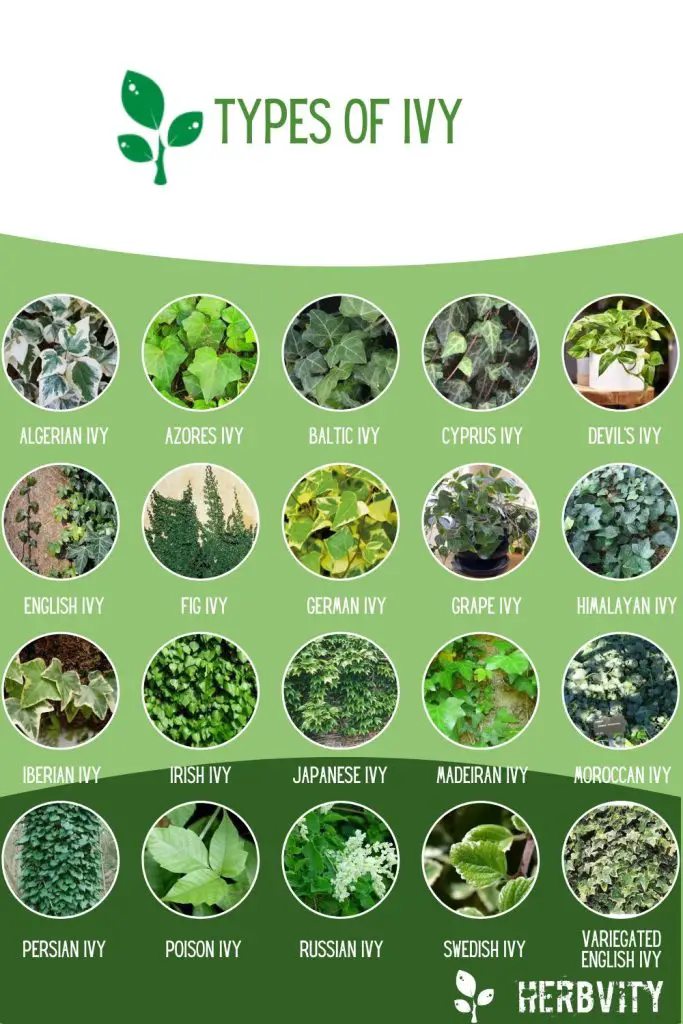
FAQs
Can ivy be grown indoors?

Despite its reputation as an outdoor plant, the ivy plant is quite a popular houseplant. It thrives indoors and grows best in well-drained soil and on exposure to indirect light.
Does ivy require lots of direct sunlight?
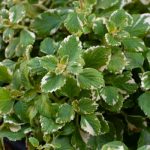
Ivy plants are known to tolerate shade although they require bright light in order to grow. However, placing them in direct sunlight is not recommended as too much sunlight tends to damage the foliage, scorching the leaves.
Do ivy plants kill trees?
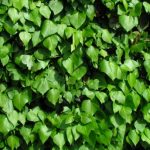
This is a myth and is not entirely true. The ivy plant can cause some difficulty for trees if the tree is already weak or diseased but it does not cling to the tree or draw sustenance from them.
Are ivies parasitic plants?

No, they are not parasitic plants. Ivy plants lay their roots on the ground and get all the nutrients from sunlight and their roots. They only climb trees as a form of vertical support.
How do I manage ivy and prevent it from being invasive?

Ivy is a naturally invasive plant and in order to manage it effectively, it has to be contained and not allowed to grow freely on the ground. Regular pruning is also important because it is a fast-growing plant and if not closely monitored, would spread aggressively.
Conclusion
Ivies are hardy, fast-growing, evergreen vines with climbing traits that can be found all year round. Listed and explained above are sixteen (16) types of ivy by species and six (6) other types of plants called ivy.
It is also a very controversial plant, most times considered an invasive species and weedy, but it has proven to be useful for medicinal, practical and ornamental purposes.
In addition to its practicality, ivy plants are beneficial to the environment. They help control soil erosion, act as air purifiers by filtering pollutants from the atmosphere, and are a source of food to birds and bees. There are still so many types of ivy plants.
More plant stuff
